Estimation of Actual Evapotranspiration and Water Stress in Typical Irrigation Areas in Xinjiang, Northwest China
Abstract
1. Introduction
2. Data and Methods
2.1. Study Area
2.2. Data
2.2.1. Satellite Data
2.2.2. Other Data
2.3. Methods
2.3.1. SEBAL Model Description
2.3.2. Model Assessment
- (i)
- Pearson correlation coefficient (R):
- (ii)
- Root Mean Square Error (RMSE):
- (iii)
- Mean Absolute Error (MAE):
2.3.3. Water Stress Algorithm
- (i)
- Water Stress Index (WSI)
3. Results
3.1. Evaluation Results of the SEBAL Model
3.2. Temporal Variations in ETa
3.3. Spatial Heterogeneity of ETa
3.4. Water Stress Variation
4. Discussion
4.1. Accuracy Assessment of the SEBAL Model
4.2. Driving Factors of Spatial–Temporal Changes in ETa and WSI
4.2.1. Meteorological Factors
4.2.2. Regional Water Supply
4.2.3. Irrigation Area and Planting Patterns
4.2.4. Irrigation Modes
5. Conclusions
Author Contributions
Funding
Data Availability Statement
Conflicts of Interest
References
- UN. World Water Development Report. 2020. Available online: https://www.unwater.org/publications/un-world-water-development-report-2020 (accessed on 21 March 2020).
- Liu, J.; Yang, H.; Gosling, S.N.; Kummu, M.; Flörke, M.; Pfister, S.; Hanasaki, N.; Wada, Y.; Zhang, X.; Zheng, C. Water scarcity assessments in the past, present, and future. Earth’s Future 2017, 5, 545–559. [Google Scholar] [CrossRef] [PubMed]
- Oki, T.; Kanae, S. Global hydrological cycles and world water resources. Science 2006, 313, 1068–1072. [Google Scholar] [CrossRef] [PubMed]
- Liu, M.; Tang, R.; Li, Z.-L.; Yan, G. Integration of two semi-physical models of terrestrial evapotranspiration using the China Meteorological Forcing Dataset. Int. J. Remote Sens. 2019, 40, 1966–1980. [Google Scholar] [CrossRef]
- Schewe, J.; Heinke, J.; Gerten, D.; Haddeland, I.; Arnell, N.W.; Clark, D.B.; Dankers, R.; Eisner, S.; Fekete, B.M.; Colón-González, F.J. Multimodel assessment of water scarcity under climate change. Proc. Natl. Acad. Sci. USA 2014, 111, 3245–3250. [Google Scholar] [CrossRef]
- Sun, H.; Chen, J.; Yang, Y.; Yan, D.; Xue, J.; Wang, J.; Zhang, W. Assessment of long-term water stress for ecosystems across China using the maximum entropy production theory-based evapotranspiration product. J. Clean. Prod. 2022, 349, 131414. [Google Scholar] [CrossRef]
- Jiang, L.; Bao, A.; Yuan, Y.; Zheng, G.; Guo, H.; Yu, T.; De Maeyer, P. The effects of water stress on croplands in the Aral Sea basin. J. Clean. Prod. 2020, 254, 120114. [Google Scholar] [CrossRef]
- Jahangir, M.H.; Arast, M. Remote sensing products for predicting actual evapotranspiration and water stress footprints under different land cover. J. Clean. Prod. 2020, 266, 121818. [Google Scholar] [CrossRef]
- Duan, Z.; Bastiaanssen, W. Evaluation of three energy balance-based evaporation models for estimating monthly evaporation for five lakes using derived heat storage changes from a hysteresis model. Res. Lett. 2017, 12, 024005. [Google Scholar] [CrossRef]
- Liu, S.; Xu, Z.; Song, L.; Zhao, Q.; Ge, Y.; Xu, T.; Ma, Y.; Zhu, Z.; Jia, Z.; Zhang, F. Upscaling evapotranspiration measurements from multi-site to the satellite pixel scale over heterogeneous land surfaces. Agric. For. Meteorol. 2016, 230, 97–113. [Google Scholar] [CrossRef]
- Liou, Y.-A.; Kar, S.K. Evapotranspiration estimation with remote sensing and various surface energy balance algorithms—A review. Energies 2014, 7, 2821–2849. [Google Scholar] [CrossRef]
- Liu, Z.; Huang, Y.; Liu, T.; Li, J.; Xing, W.; Akmalov, S.; Peng, J.; Pan, X.; Guo, C.; Duan, Y. Water balance analysis based on a quantitative evapotranspiration inversion in the Nukus irrigation area, Lower Amu River Basin. Remote Sens. 2020, 12, 2317. [Google Scholar] [CrossRef]
- Wang, K.; Dickinson, R.E.; Wild, M.; Liang, S. Evidence for decadal variation in global terrestrial evapotranspiration between 1982 and 2002: 1. Model development. J. Geophys. Res. Atmos. 2010, 115. [Google Scholar] [CrossRef]
- Yao, Y.; Di, Z.; Xie, Z.; Xiao, Z.; Jia, K.; Zhang, X.; Shang, K.; Yang, J.; Bei, X.; Guo, X. Simplified priestley–taylor model to estimate land-surface latent heat of evapotranspiration from incident shortwave radiation, satellite vegetation index, and air relative humidity. Remote Sens. 2021, 13, 902. [Google Scholar] [CrossRef]
- Yao, Y.; Liang, S.; Li, X.; Chen, J.; Wang, K.; Jia, K.; Cheng, J.; Jiang, B.; Fisher, J.B.; Mu, Q. A satellite-based hybrid algorithm to determine the Priestley–Taylor parameter for global terrestrial latent heat flux estimation across multiple biomes. Remote Sens. Environ. 2015, 165, 216–233. [Google Scholar] [CrossRef]
- Bai, Y.; Zhang, S.; Bhattarai, N.; Mallick, K.; Liu, Q.; Tang, L.; Im, J.; Guo, L.; Zhang, J. On the use of machine learning based ensemble approaches to improve evapotranspiration estimates from croplands across a wide environmental gradient. Agric. For. Meteorol. 2021, 298, 108308. [Google Scholar] [CrossRef]
- Carter, C.; Liang, S. Evaluation of ten machine learning methods for estimating terrestrial evapotranspiration from remote sensing. Int. J. Appl. Earth Obs. Geoinf. 2019, 78, 86–92. [Google Scholar] [CrossRef]
- Shiri, J. Improving the performance of the mass transfer-based reference evapotranspiration estimation approaches through a coupled wavelet-random forest methodology. J. Hydrol. 2018, 561, 737–750. [Google Scholar] [CrossRef]
- Xu, T.; Guo, Z.; Liu, S.; He, X.; Meng, Y.; Xu, Z.; Xia, Y.; Xiao, J.; Zhang, Y.; Ma, Y. Evaluating different machine learning methods for upscaling evapotranspiration from flux towers to the regional scale. J. Geophys. Res. Atmos. 2018, 123, 8674–8690. [Google Scholar] [CrossRef]
- Chen, Y.; Yuan, W.; Xia, J.; Fisher, J.B.; Dong, W.; Zhang, X.; Liang, S.; Ye, A.; Cai, W.; Feng, J. Using Bayesian model averaging to estimate terrestrial evapotranspiration in China. J. Hydrol. 2015, 528, 537–549. [Google Scholar] [CrossRef]
- Yang, Y.; Sun, H.; Xue, J.; Liu, Y.; Liu, L.; Yan, D.; Gui, D. Estimating evapotranspiration by coupling Bayesian model averaging methods with machine learning algorithms. Environ. Monit. Assess. 2021, 193, 156. [Google Scholar] [CrossRef]
- Yuan, Q.; Shen, H.; Li, T.; Li, Z.; Li, S.; Jiang, Y.; Xu, H.; Tan, W.; Yang, Q.; Wang, J. Deep learning in environmental remote sensing: Achievements and challenges. Remote Sens. Environ. 2020, 241, 111716. [Google Scholar] [CrossRef]
- Long, D.; Singh, V.P. A two-source trapezoid model for evapotranspiration (TTME) from satellite imagery. Remote Sens. Environ. 2012, 121, 370–388. [Google Scholar] [CrossRef]
- Tang, R.; Li, Z.-L.; Tang, B. An application of the Ts–VI triangle method with enhanced edges determination for evapotranspiration estimation from MODIS data in arid and semi-arid regions: Implementation and validation. Remote Sens. Environ. 2010, 114, 540–551. [Google Scholar] [CrossRef]
- Wu, B.; Yan, N.; Xiong, J.; Bastiaanssen, W.; Zhu, W.; Stein, A. Validation of ETWatch using field measurements at diverse landscapes: A case study in Hai Basin of China. J. Hydrol. 2012, 436, 67–80. [Google Scholar] [CrossRef]
- Zhang, Y.; Kong, D.; Gan, R.; Chiew, F.H.; McVicar, T.R.; Zhang, Q.; Yang, Y. Coupled estimation of 500 m and 8-day resolution global evapotranspiration and gross primary production in 2002–2017. Remote Sens. Environ. 2019, 222, 165–182. [Google Scholar] [CrossRef]
- Allen, R.G.; Tasumi, M.; Trezza, R. Satellite-based energy balance for mapping evapotranspiration with internalized calibration (METRIC)—Model. J. Irrig. Drain. Eng. 2007, 133, 380–394. [Google Scholar] [CrossRef]
- Qiu, G.Y.; Li, C.; Yan, C. Characteristics of soil evaporation, plant transpiration and water budget of Nitraria dune in the arid Northwest China. Agric. For. Meteorol. 2015, 203, 107–117. [Google Scholar] [CrossRef]
- Song, L.; Kustas, W.P.; Liu, S.; Colaizzi, P.D.; Nieto, H.; Xu, Z.; Ma, Y.; Li, M.; Xu, T.; Agam, N. Applications of a thermal-based two-source energy balance model using Priestley-Taylor approach for surface temperature partitioning under advective conditions. J. Hydrol. 2016, 540, 574–587. [Google Scholar] [CrossRef]
- Cheng, M.; Jiao, X.; Li, B.; Yu, X.; Shao, M.; Jin, X. Long time series of daily evapotranspiration in China based on the SEBAL model and multisource images and validation. Earth Syst. Sci. Data 2021, 13, 3995–4017. [Google Scholar] [CrossRef]
- De Lima, C.E.S.; De Oliveira Costa, V.S.; Galvíncio, J.D.; Da Silva, R.M.; Santos, C.A.G. Assessment of automated evapotranspiration estimates obtained using the GP-SEBAL algorithm for dry forest vegetation (Caatinga) and agricultural areas in the Brazilian semiarid region. Agric. Water Manag. 2021, 250, 106863. [Google Scholar] [CrossRef]
- Liu, Z.; Liu, T.; Huang, Y.; Duan, Y.; Pan, X.; Wang, W. Comparison of crop evapotranspiration and water productivity of typical delta irrigation areas in Aral Sea Basin. Remote Sens. 2022, 14, 249. [Google Scholar] [CrossRef]
- Taheri, M.; Emadzadeh, M.; Gholizadeh, M.; Tajrishi, M.; Ahmadi, M.; Moradi, M. Investigating the temporal and spatial variations of water consumption in Urmia Lake River Basin considering the climate and anthropogenic effects on the agriculture in the basin. Agric. Water Manag. 2019, 213, 782–791. [Google Scholar] [CrossRef]
- Yang, L.; Li, J.; Sun, Z.; Liu, J.; Yang, Y.; Li, T. Daily actual evapotranspiration estimation of different land use types based on SEBAL model in the agro-pastoral ecotone of northwest China. PLoS ONE 2022, 17, e0265138. [Google Scholar] [CrossRef] [PubMed]
- Senay, G.B.; Friedrichs, M.; Morton, C.; Parrish, G.E.; Schauer, M.; Khand, K.; Kagone, S.; Boiko, O.; Huntington, J. Mapping actual evapotranspiration using Landsat for the conterminous United States: Google Earth Engine implementation and assessment of the SSEBop model. Remote Sens. Environ. 2022, 275, 113011. [Google Scholar] [CrossRef]
- Teluguntla, P.; Thenkabail, P.S.; Oliphant, A.; Xiong, J.; Gumma, M.K.; Congalton, R.G.; Yadav, K.; Huete, A. A 30-m landsat-derived cropland extent product of Australia and China using random forest machine learning algorithm on Google Earth Engine cloud computing platform. ISPRS J. Photogramm. Remote Sens. 2018, 144, 325–340. [Google Scholar] [CrossRef]
- Gorelick, N.; Hancher, M.; Dixon, M.; Ilyushchenko, S.; Thau, D.; Moore, R. Google Earth Engine: Planetary-scale geospatial analysis for everyone. Remote Sens. Environ. 2017, 202, 18–27. [Google Scholar] [CrossRef]
- Liaqat, U.W.; Choi, M. Accuracy comparison of remotely sensed evapotranspiration products and their associated water stress footprints under different land cover types in Korean peninsula. J. Clean. Prod. 2017, 155, 93–104. [Google Scholar] [CrossRef]
- Yao, Y.; Mallik, A.U. Estimation of actual evapotranspiration and water stress in the Lijiang River Basin, China using a modified Operational Simplified Surface Energy Balance (SSEBop) model. J. Hydro-Environ. Res. 2022, 41, 1–11. [Google Scholar] [CrossRef]
- Bastiaanssen, W.G.; Menenti, M.; Feddes, R.; Holtslag, A. A remote sensing surface energy balance algorithm for land (SEBAL). 1. Formulation. J. Hydrol. 1998, 212, 198–212. [Google Scholar] [CrossRef]
- Losgedaragh, S.Z.; Rahimzadegan, M. Evaluation of SEBS, SEBAL, and METRIC models in estimation of the evaporation from the freshwater lakes (Case study: Amirkabir dam, Iran). J. Hydrol. 2018, 561, 523–531. [Google Scholar] [CrossRef]
- Allen, R.; Tasumi, M.; Trezza, R.S.; Bastiaanssen, W. Surface Energy Balance Algorithm for Land: Advanced Training and Users Manual; University of Idaho: Moscow, ID, USA, 2002; pp. 1–98. [Google Scholar]
- Allen, R.G.; Pereira, L.S.; Raes, D.; Smith, M. Crop Evapotranspiration—Guidelines for Computing Crop Water Requirements—FAO Irrigation and Drainage Paper 56; FAO: Rome, Italy, 1998; Volume 300, p. D05109. [Google Scholar]
- Zhang, Y.; Wegehenkel, M. Integration of MODIS data into a simple model for the spatial distributed simulation of soil water content and evapotranspiration. Remote Sens. Environ. 2006, 104, 393–408. [Google Scholar] [CrossRef]
- Liao, J.; Lei, B.; Su, T.; Liu, W.; Zhang, W.; Zhu, F. Prediction of winter wheat water demand based on remote sensing modified crop coefficient. Water Sav. Irrig. 2023, 3, 48–52,60. [Google Scholar]
- Quan, Z.; Zuo, Q.; Wang, P.; Zhang, Y. Ecological vulnerability analysis of the Qin River basin based on SWAT and water stress index. J. North China Univ. Water Resour. Electr. Power (Nat. Sci. Ed.) 2024, 45, 15–24. [Google Scholar]
- Muñoz-Sabater, J.; Dutra, E.; Agustí-Panareda, A.; Albergel, C.; Arduini, G.; Balsamo, G.; Boussetta, S.; Choulga, M.; Harrigan, S.; Hersbach, H. ERA5-Land: A state-of-the-art global reanalysis dataset for land applications. Earth Syst. Sci. Data 2021, 13, 4349–4383. [Google Scholar] [CrossRef]
- Biggs, T.W.; Marshall, M.; Messina, A. Mapping daily and seasonal evapotranspiration from irrigated crops using global climate grids and satellite imagery: Automation and methods comparison. Water Resour. Res. 2016, 52, 7311–7326. [Google Scholar] [CrossRef]
- Laipelt, L.; Ruhoff, A.L.; Fleischmann, A.S.; Kayser, R.H.B.; Kich, E.d.M.; da Rocha, H.R.; Neale, C.M.U. Assessment of an automated calibration of the SEBAL algorithm to estimate dry-season surface-energy partitioning in a forest–savanna transition in Brazil. Remote Sens. 2020, 12, 1108. [Google Scholar] [CrossRef]
- Yang, Y. Study on Water Balance in Kaidu-Kongqi River Basin Using Remote-Sensing Data. Master’s Thesis, China University of Geosciences (Beijing), Beijing, China, 2021. [Google Scholar]
- Shi, C.; Niu, K.; Chen, T.; Zhu, X. The study of pan coefficients of evaporation pans of water. Sci. Geogr. Sin. 1986, 6, 305–313. [Google Scholar]
- Cha, M.; Li, M.; Wang, X. Estimation of Seasonal Evapotranspiration for Crops in Arid Regions Using Multisource Remote Sensing Images. Remote Sens. 2020, 12, 2398. [Google Scholar] [CrossRef]
- Li, Z. Analysis of Evapotranspiration Change in the Arid Region of Northwest China. Ph.D. Thesis, Xinjiang Institute of Ecology and Geography Chinese Academy of Sciences, Ürümqi, China, 2014. [Google Scholar]
- He, H.; Jin, X.; Hao, M.; Lang, J.; Zhang, X. Temporal-spatial distribution characteristics of evapotranspiration and its influencing factors in Tarim basin. Water Resour. Hydropower Eng. 2023, 54, 60–74. [Google Scholar]
- Han, J. A Study on the Influential Factors of Water Requirement of Crops in Hexi Region and the Optimal Distribution of Water Resources. Ph.D. Thesis, Lanzhou University, Lanzhou, China, 2017. [Google Scholar]
- Meng, J.; Yao, X.; Yang, X.; Luo, J.; Shen, Y. Spatial and Temporal Evolution of Agricultural Planting Structure and Crop Water Consumption in Groundwater Overdraft Area. Trans. Chin. Soc. Agric. Mach. 2020, 51, 302–312. [Google Scholar]
- Pan, S.; Pan, N.; Tian, H.; Friedlingstein, P.; Sitch, S.; Shi, H.; Arora, V.K.; Haverd, V.; Jain, A.K.; Kato, E. Evaluation of global terrestrial evapotranspiration using state-of-the-art approaches in remote sensing, machine learning and land surface modeling. Hydrol. Earth Syst. Sci. 2020, 24, 1485–1509. [Google Scholar] [CrossRef]
- McDermid, S.; Nocco, M.; Lawston-Parker, P.; Keune, J.; Pokhrel, Y.; Jain, M.; Jägermeyr, J.; Brocca, L.; Massari, C.; Jones, A.D. Irrigation in the Earth system. Nat. Rev. Earth Environ. 2023, 4, 435–453. [Google Scholar] [CrossRef]
- Peng, J. Environmental Flows Assessment and Regulation of Bosten Lake Wetland. Ph.D. Thesis, Xinjiang Institute of Ecology and Geography Chinese Academy of Sciences, Ürümqi, China, 2022. [Google Scholar]
- Zou, M.; Niu, J.; Kang, S.; Li, X.; Lu, H. The contribution of human agricultural activities to increasing evapotranspiration is significantly greater than climate change effect over Heihe agricultural region. Sci. Rep. 2017, 7, 8805. [Google Scholar] [CrossRef] [PubMed]
- Deng, M.; Wang, Q.; Tao, W.; Wang, Z.; Cao, J. Development Model for Improving the Quality and Efficiency of Modern Agriculture in the Arid Region of Northwest China. Strateg. Study CAE 2023, 25, 59–72. [Google Scholar] [CrossRef]
- Ding, R.; Kang, S.; Zhang, Y.; Hao, X.; Tong, L.; Du, T. Partitioning evapotranspiration into soil evaporation and transpiration using a modified dual crop coefficient model in irrigated maize field with ground-mulching. Agric. Water Manag. 2013, 127, 85–96. [Google Scholar] [CrossRef]


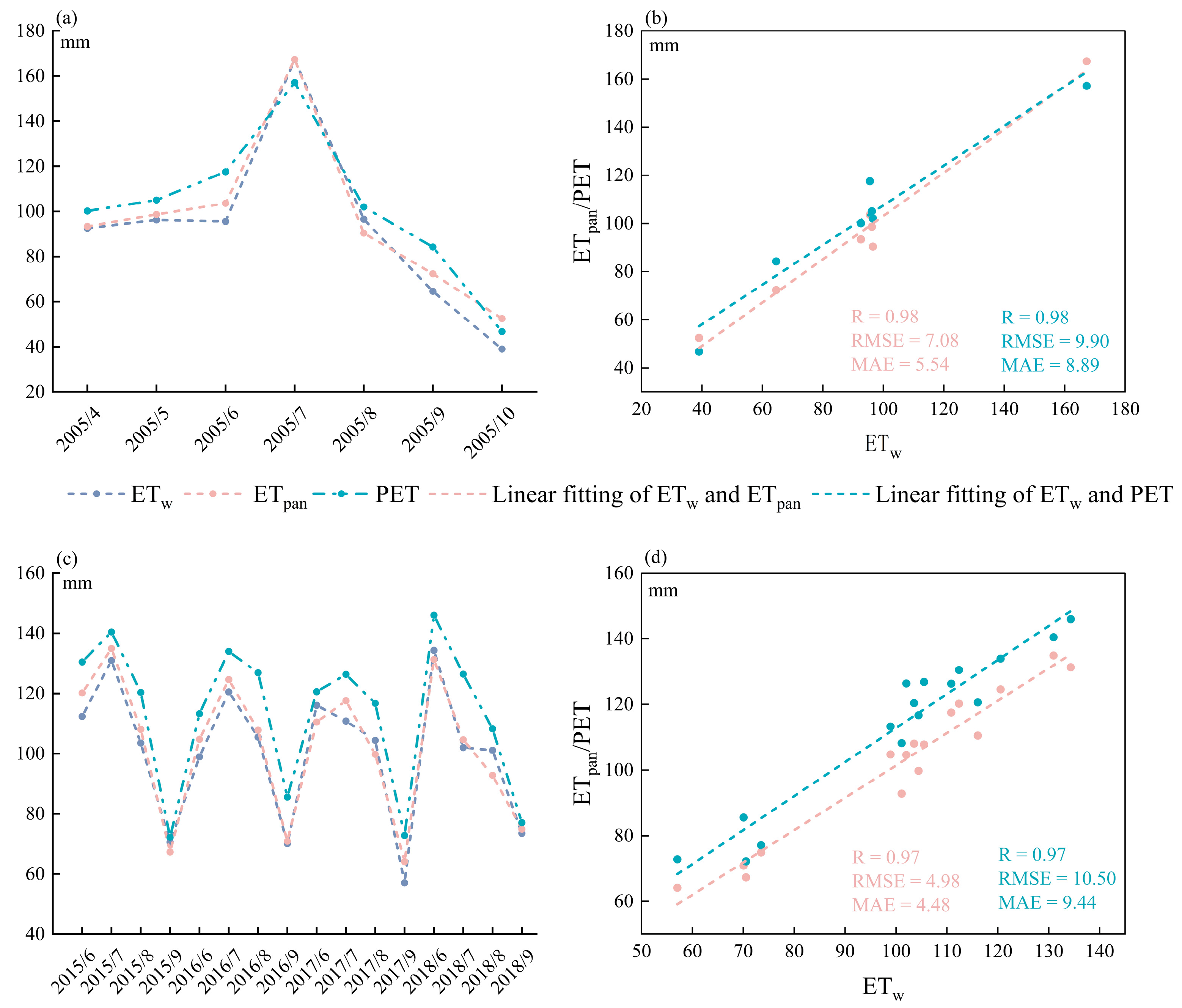
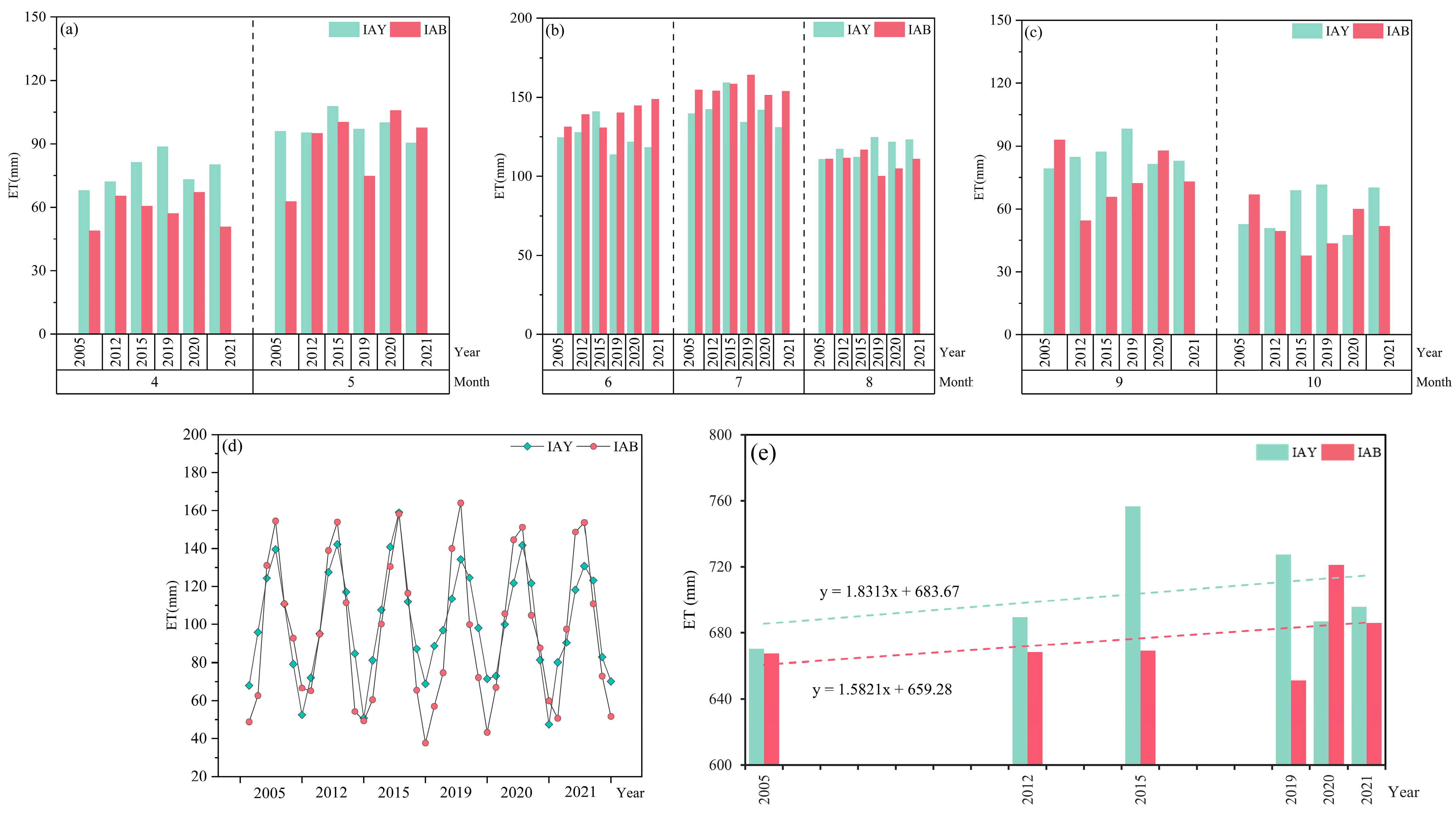
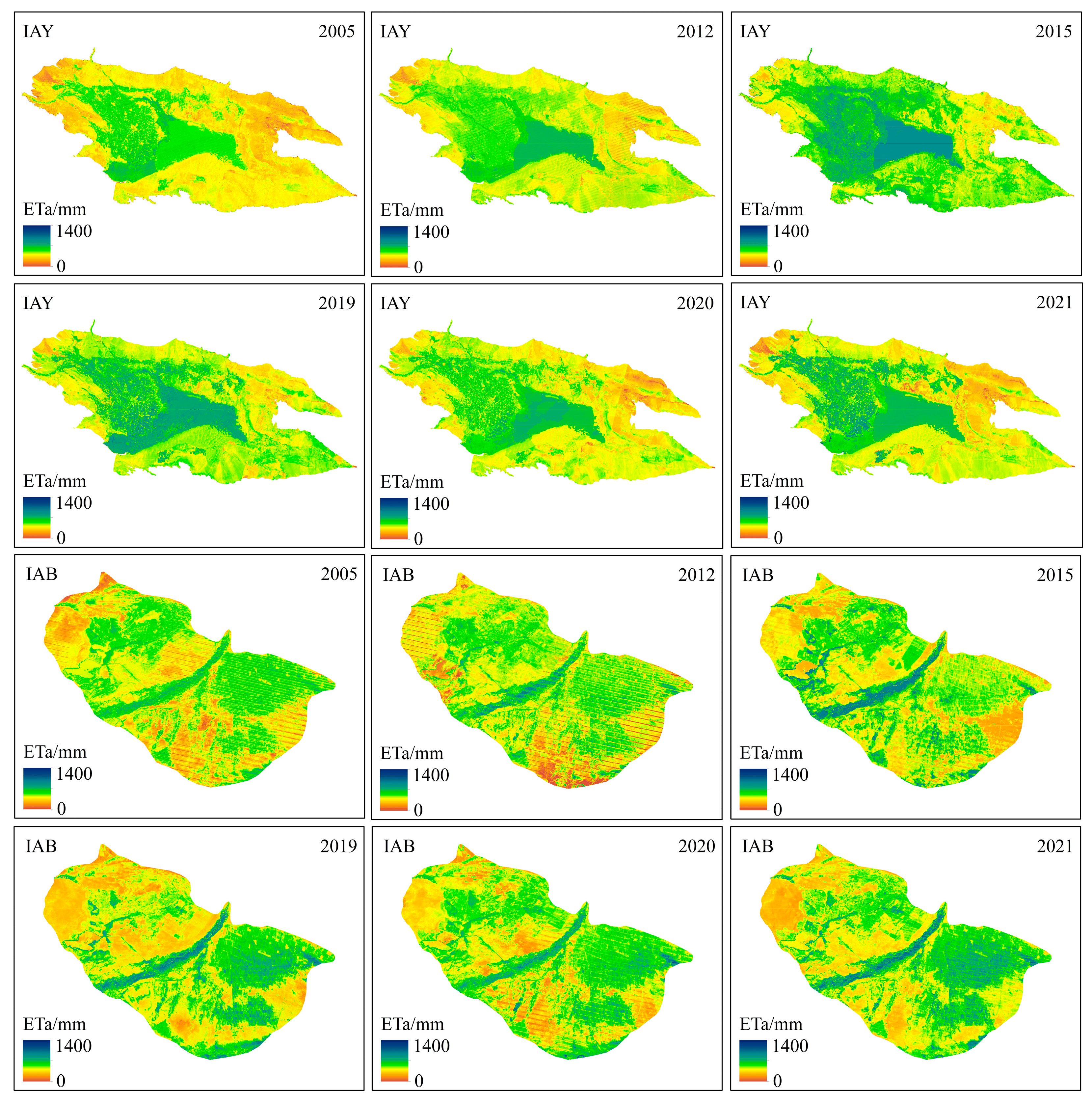
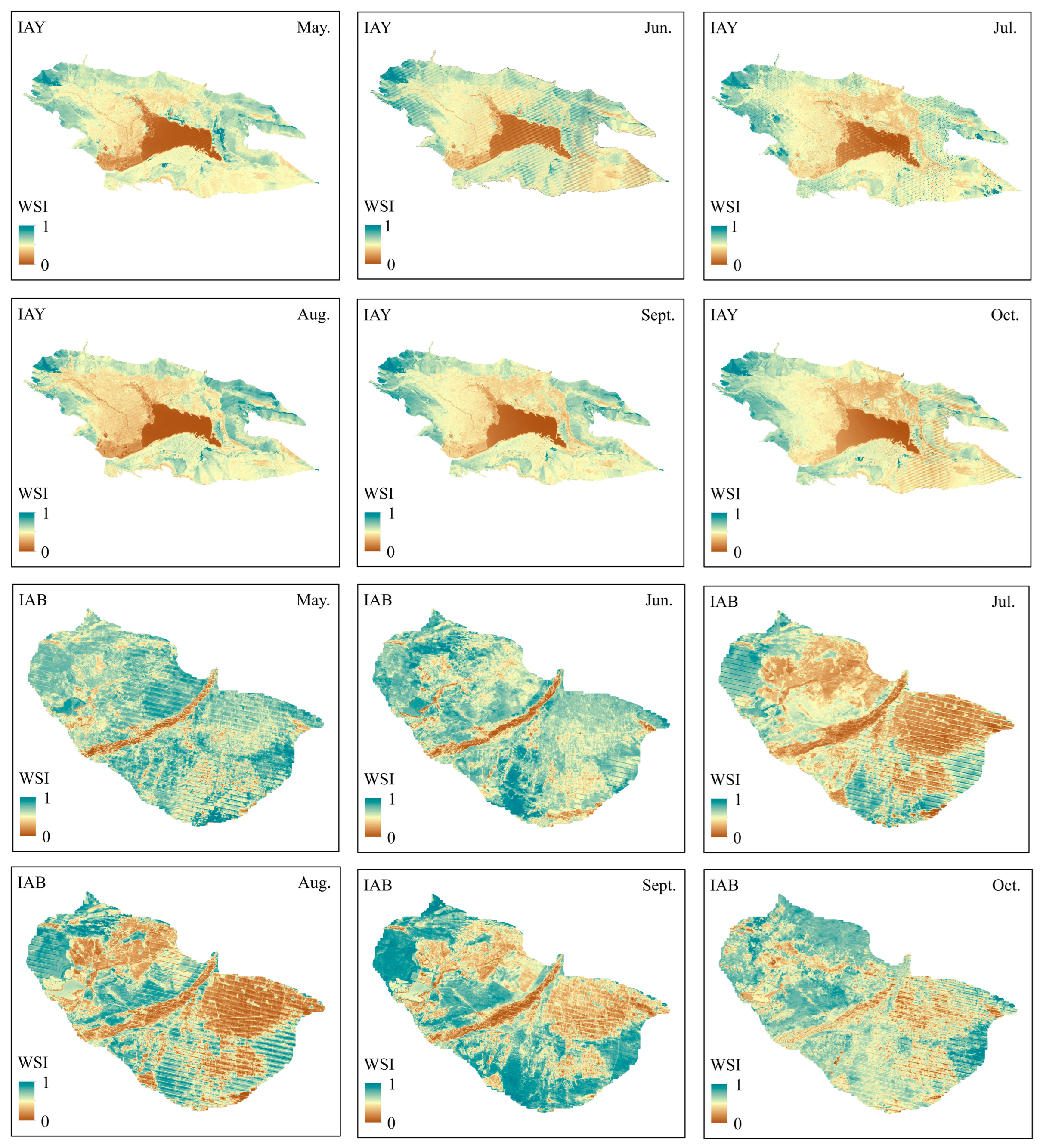
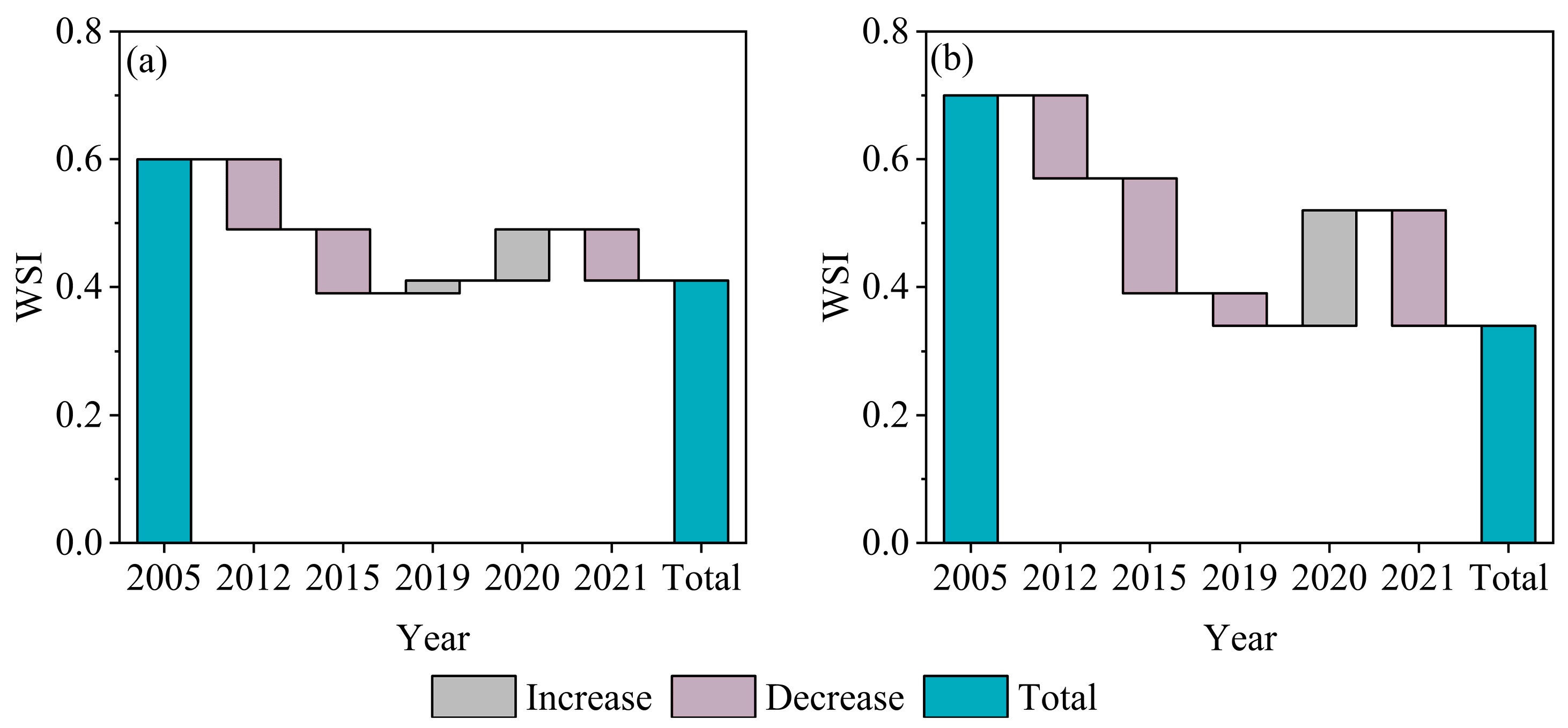
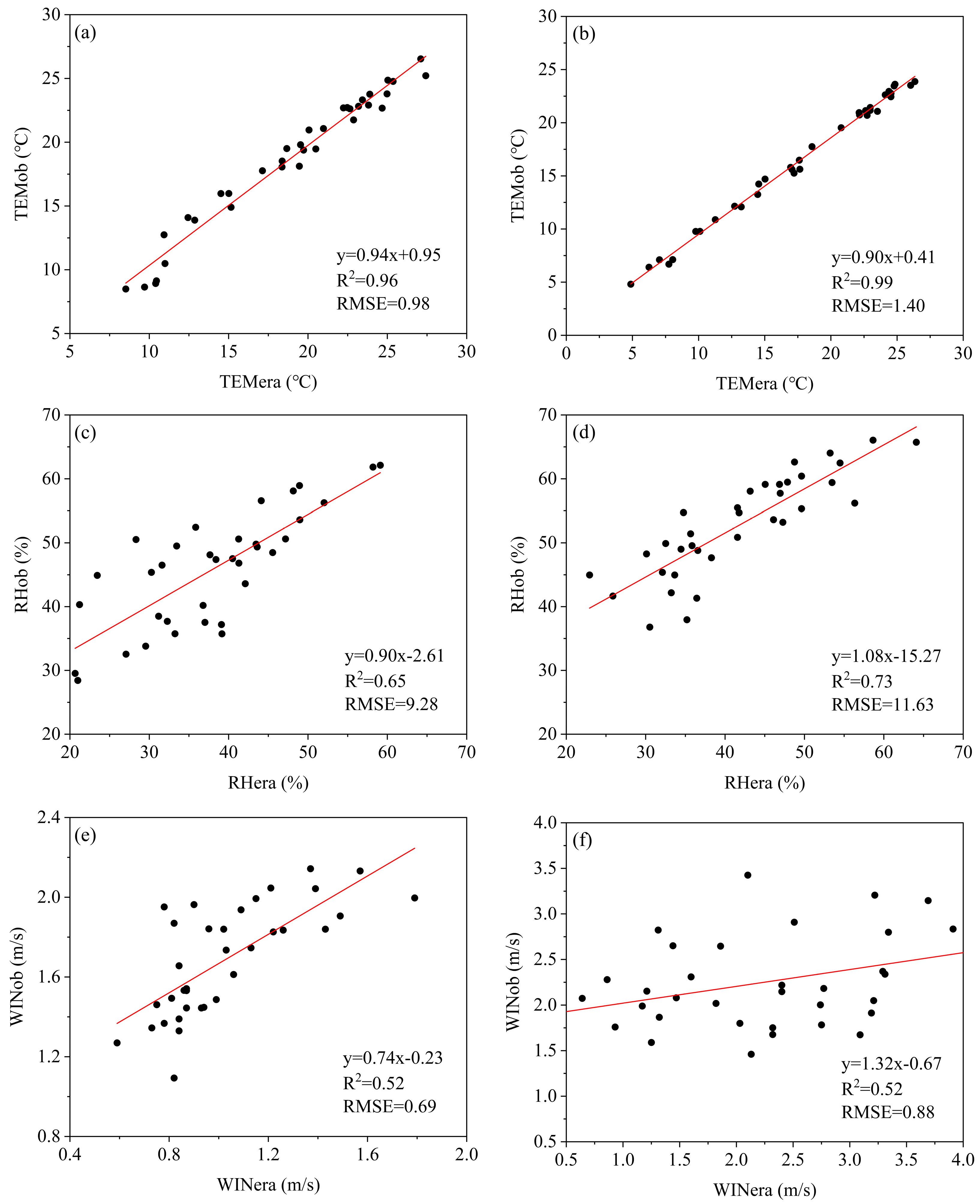


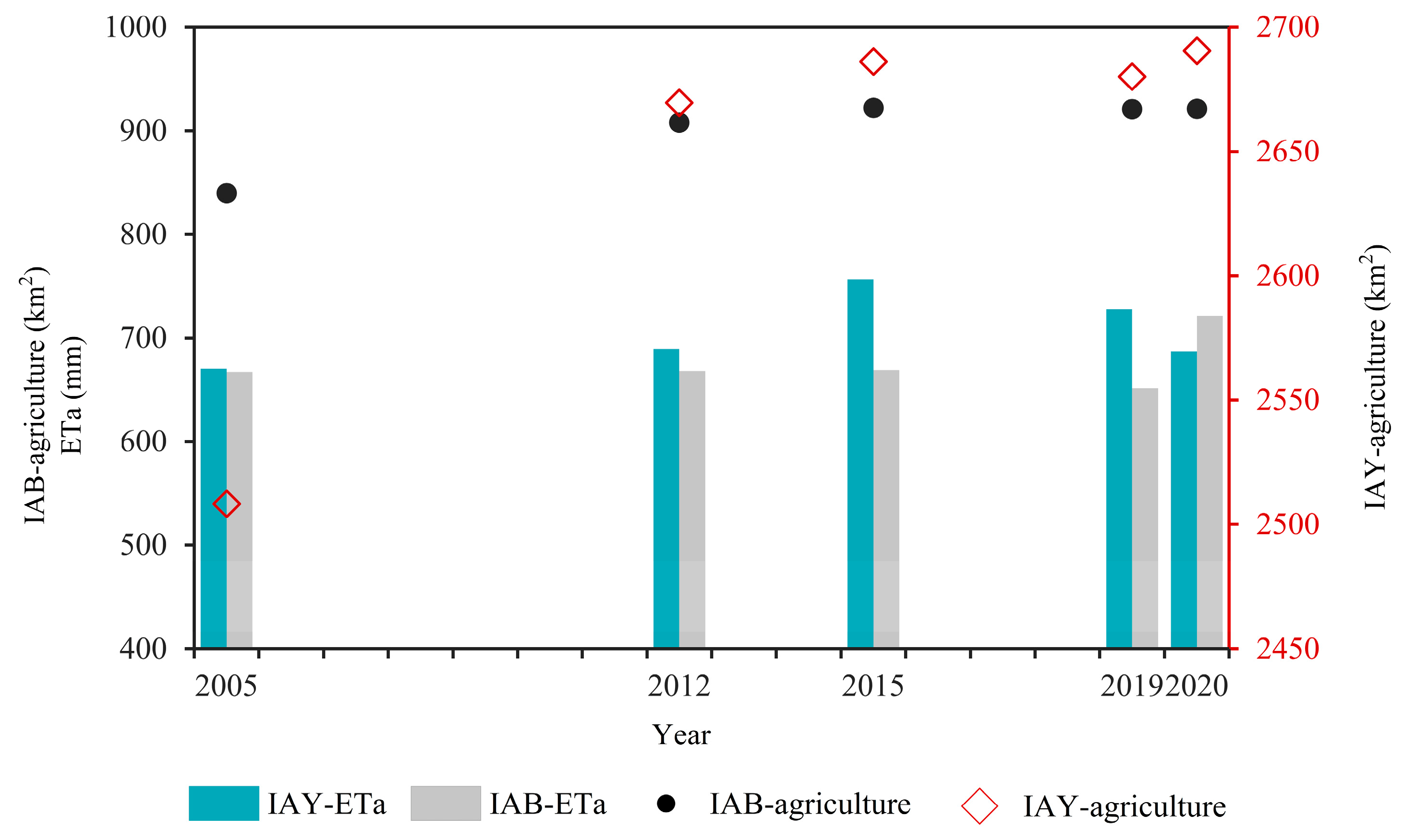
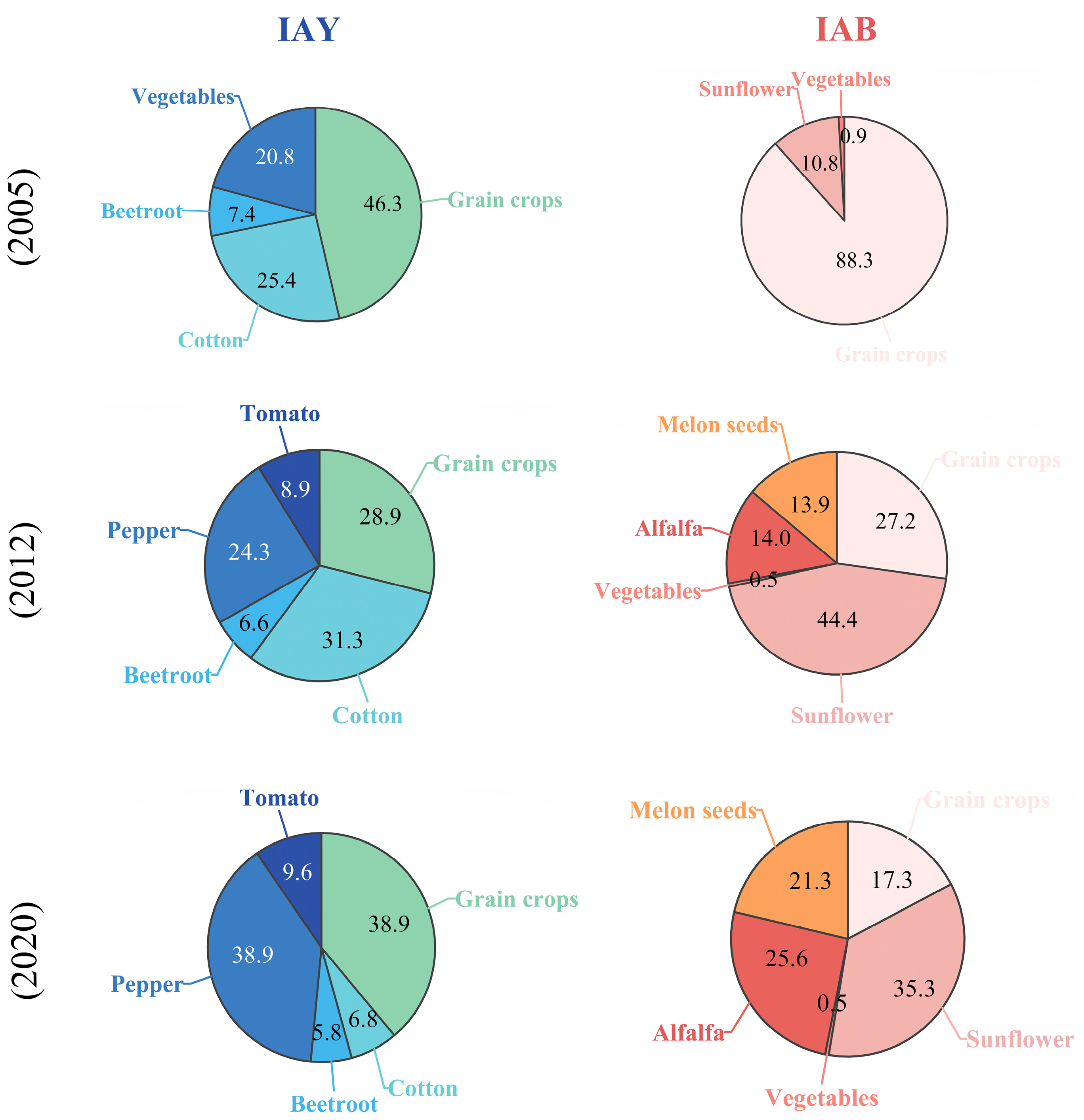
| Product | GEE ID | Band | Spatial Resolution | Time Coverage |
|---|---|---|---|---|
| LANDSAT 8 OLI/TIRS | LANDSAT/LC08/C01/T1_SR | Surface reflectance; Brightness temperature; Pixel QA (quality attributes); | 30 m | March 2013–December 2021 |
| LANDSAT 7 ETM+ | LANDSAT/LE07/C02/T1_SR | Surface reflectance; Brightness temperature; Pixel QA (quality attributes); | 30 m | May 1999–Present |
| LANDSAT 5 TM | LANDSAT/LT05/C01/T1_SR | Surface reflectance; Brightness temperature; Pixel QA (quality attributes); | 30 m | March 1984–May 2012 |
| ERA5-Land | ECMWF/ERA5-LAND/MONTHLY_AGGR | Air temperature at 2 m; Dew point temperature at 2 m; Eastward wind speed at 10 m; | 0.1° | February 1950–Present |
| MODIS | MODIS/006/MOD10A1 | NDSI snow cover class | 500 m | February 2000–Present |
| MODIS | MODIS/006/MCD12Q1 | Land Cover Type1 from IGBP classification | 500 m | January 2001–January 2020 |
| SRTM | CGIAR/SRTM90_V4 | Elevation | 90 m | One survey mission (February 2000) |
| Data Type | Station Name | Study Area in Which the Site Is Located | Observation Variables | Period |
|---|---|---|---|---|
| Meteorological data | Yanqi station | IAY | Average temperature, maximum temperature, minimum temperature, relative humidity, average wind speed, average air pressure, sunshine hours, precipitation, pan evaporation | 2005–2021 |
| Hejing station | IAY | |||
| Heshuo station | IAY | |||
| Burqin station | IAB | |||
| Hydrological data | Dashankou station | IAY | Runoff | 2000–2018 |
| Qunkule station | IAB |
| Threshold | Classification |
|---|---|
| WSI ≤ 0.2 | Free water stress |
| 0.2 < WSI ≤ 0.4 | Low water stress |
| 0.4 < WSI ≤ 0.6 | Moderate water stress |
| 0.6 < WSI ≤ 0.8 | Severe water stress |
| WSI > 0.8 | Extreme water stress |
| Study Area | Crop | Number of Sampling Points | Correlation | Passing Rate (>0.6) | RMSE (mm) | MAE (mm) | ||
|---|---|---|---|---|---|---|---|---|
| >0.8 | 0.6~0.8 | <0.6 | ||||||
| IAY | Corn | 48 | 31 | 9 | 8 | 0.83 | 6.78 | 5.83 |
| Pepper | 122 | 66 | 19 | 37 | 0.69 | 8.27 | 7.49 | |
| Tomato | 39 | 16 | 9 | 14 | 0.64 | 6.88 | 5.77 | |
| IAB | Corn | 102 | 96 | 4 | 2 | 0.98 | 6.11 | 5.14 |
| Sunflower | 57 | 54 | 0 | 3 | 0.94 | 4.03 | 3.37 | |
| Alfalfa | 10 | 7 | 2 | 1 | 0.90 | 4.95 | 4.03 | |
| Study Area | Crop | Month | ETc (mm) | ETa (mm) |
|---|---|---|---|---|
| IAY | Corn | June | 134.33 | 147.12 |
| July | 211.74 | 205.85 | ||
| August | 167.49 | 170.54 | ||
| Pepper | June | 186.23 | 190.11 | |
| July | 186.05 | 196.77 | ||
| August | 143.30 | 158.45 | ||
| Tomato | June | 195.46 | 193.99 | |
| July | 203.18 | 209.27 | ||
| August | 133.29 | 140.66 | ||
| IAB | Corn | June | 93.65 | 86.39 |
| July | 161.15 | 166.68 | ||
| August | 125.23 | 136.64 | ||
| Sunflower | May | 80.76 | 81.08 | |
| June | 128.56 | 134.77 | ||
| July | 89.66 | 81.58 | ||
| Alfalfa | June | 128.22 | 124.52 | |
| July | 148.83 | 157.05 | ||
| August | 156.71 | 150.53 |
| Study Area | Forest | Grass | Water | Farmland | Urban | Unused Land |
|---|---|---|---|---|---|---|
| IAY | 0.51 | 0.48 | 0.11 | 0.38 | 0.40 | 0.56 |
| IAB | 0.58 | 0.57 | 0.14 | 0.47 | 0.56 | 0.67 |
Disclaimer/Publisher’s Note: The statements, opinions and data contained in all publications are solely those of the individual author(s) and contributor(s) and not of MDPI and/or the editor(s). MDPI and/or the editor(s) disclaim responsibility for any injury to people or property resulting from any ideas, methods, instructions or products referred to in the content. |
© 2024 by the authors. Licensee MDPI, Basel, Switzerland. This article is an open access article distributed under the terms and conditions of the Creative Commons Attribution (CC BY) license (https://creativecommons.org/licenses/by/4.0/).
Share and Cite
Zhao, S.; Huang, Y.; Liu, Z.; Liu, T.; Tang, X. Estimation of Actual Evapotranspiration and Water Stress in Typical Irrigation Areas in Xinjiang, Northwest China. Remote Sens. 2024, 16, 2676. https://doi.org/10.3390/rs16142676
Zhao S, Huang Y, Liu Z, Liu T, Tang X. Estimation of Actual Evapotranspiration and Water Stress in Typical Irrigation Areas in Xinjiang, Northwest China. Remote Sensing. 2024; 16(14):2676. https://doi.org/10.3390/rs16142676
Chicago/Turabian StyleZhao, Siyu, Yue Huang, Zhibin Liu, Tie Liu, and Xiaoyu Tang. 2024. "Estimation of Actual Evapotranspiration and Water Stress in Typical Irrigation Areas in Xinjiang, Northwest China" Remote Sensing 16, no. 14: 2676. https://doi.org/10.3390/rs16142676
APA StyleZhao, S., Huang, Y., Liu, Z., Liu, T., & Tang, X. (2024). Estimation of Actual Evapotranspiration and Water Stress in Typical Irrigation Areas in Xinjiang, Northwest China. Remote Sensing, 16(14), 2676. https://doi.org/10.3390/rs16142676





